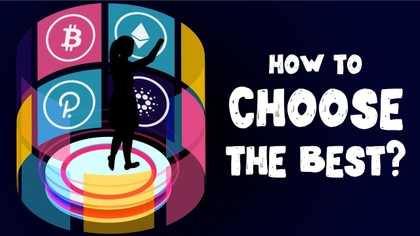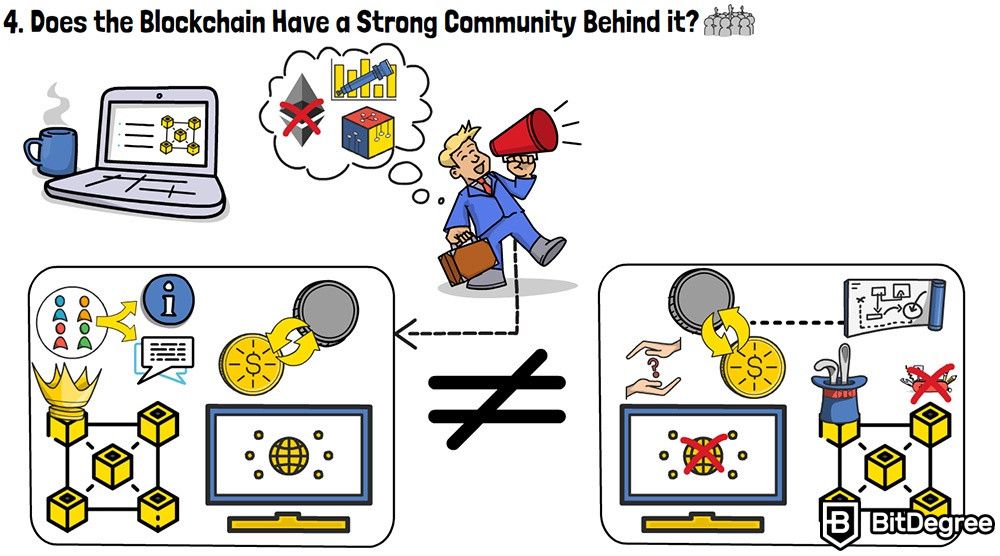1.6 Different Types of Blockchains: What to Look Out For?
Stop overpaying - start transferring money with Ogvio. Sign up, invite friends & grab Rewards now! 🎁
In this section, I’m going to tell you about the different types of blockchains out there!
Imagine that you have a line of 10 very different cars. Some of them are station wagons, some are pickup trucks - some are brand new and modern, while others barely even start. Now, while all of these objects are cars, and are able to take you from point A to point B, their characteristics are very different from one another, nonetheless.
The exact same logic can be applied to blockchains, too! There’s a huge variety of blockchains within the industry today, and all of them appear to offer their own, unique approach to solving some sort of a problem. Which blockchain projects can be trusted, though, and which of them are better to be avoided?
In this section, we’re going to take a look at some of the most important points to note, when analyzing different types of blockchains and blockchain-powered projects. We’ll talk about the most important features that all reliable blockchains should possess, and how you can spot potential scams, too!
Without further ado, let’s get to it!

Video Explainer
Video Explainer: Different Types of Blockchains: What to Look Out For?
Reading is not your thing? Watch the "Different Types of Blockchains: What to Look Out For?" video explainer
Best Types of Blockchains Revealed (5 Animated Rules)


Public VS Private Blockchains
The very first thing that you should know about blockchains, when you want to analyze them, is that there are two main types of blockchains out there - public, and private ones.
Think about it like this - imagine that you love gaming, specifically, online games that you can play with your friends. Games such as RuneScape, or World of Warcraft.
Both of these games can be played on their main, public servers - these servers are accessible to everyone, and have some established rules and guidelines about how you interact with the digital world around you.
However, it’s no secret that both games have private servers, as well. These servers are owned by some sort of a private individual, and are usually altered, quite a bit - better monster loot drop rates, more damage, rare items are made less rare, and so on. You get the idea.
While the example isn’t exactly spot-on (since both versions of the games are owned by private individuals or companies), it should still give you a pretty good idea of how private and public blockchains differ!
Public blockchains are the norm - generally speaking, they are transparent, completely decentralized, run by public nodes, and do not belong to any single authority (company, individual, organization, etc.). As opposed to that, private blockchains DO belong to a single governing entity, are governed by private nodes, and are usually very use case-specific - meaning, they are used for a very specific purpose, and thus, aren’t always available to the public.
All of that is to say that, in this section, we’re going to be focusing on the most common and popular type of blockchains - public ones. The absolute majority of all of the main cryptocurrency projects are built on these blockchains, and you’ll encounter them far more often than private ones.
Security - The Name of the Game
Now that we’ve established that much, we can move on to the points that you need to look at when analyzing types of blockchain projects. And, as far as these criteria go, you’ll find security to be at the very top of the list.
Now, if you know anything about crypto, this shouldn’t come as a surprise to you, whatsoever! After all, as I always say - if the project lacks security features, it’s not even worth looking into, in the first place!

Let’s take a look at another example with cars. Imagine that you’re looking to buy a new, modern and beautiful car - one that has a huge array of fancy features, top-tier handling on the road, and is very comfortable to drive, in general. The car is actually very affordable, as well! There’s just one issue - there is no way to lock it, at all.
So, while you CAN buy this car, and enjoy all of the perks that it has to offer, every single day, you’ll risk it being stolen, since all that the thieves would need to do is open the door - that’s it! This factor alone would probably make you think twice about buying a car like this!
Blockchains are the exact same. You should always make sure that the technology behind the blockchain is modern, secure, and bulletproof, at least theoretically. Read up about the project on the forums, check what the core developers have to say, talk to your peers, and take a look at all of the projects that are built on this blockchain - all of this should give you a pretty good idea, as far as security is concerned!

Flesh Out Your Goals
The second big thing that you really need to figure out when trying to find the best blockchains is what exactly it is that you’re interested in, in the first place.
Sound weird? Well, allow me to explain!
Certain blockchains are very user- and newbie-friendly. Meaning, they are very simple to navigate through, use, and invest in. Take Bitcoin, as an example - the blockchain doesn’t have any innate functionality, and is mainly used for investment purposes.
On the other hand, you have blockchains such as Polkadot - it’s a super-complex network that’s oriented at supporting other blockchain projects, and allowing different blockchain networks to “communicate” with one another. Now, that’s some high-end, developer-related subject matter!

If the latter sounds more like your cup of tea, then I highly recommend reading a dedicated section about Polkadot, to get a better understanding of what this network is all about. That being said, my point still stands - once you understand WHY it is that you’re researching different blockchain platforms, you’ll be able to narrow your search, significantly.
Speaking of which, this ties in perfectly with another element of your research, too.
DYOR on The Use Cases of the Blockchain
Once you have all of your goals set and clear, the third step is to find a blockchain that would allow you to manifest those goals into reality! Allow me to illustrate what I mean with an example.
So, imagine that your significant other sent you to a grocery store to do some shopping. Now, if your goal was to buy some milk and bread, but you, for some reason, decide to go shopping in a clothing store, instead of a grocery shop, chances are that you won’t find any milk or bread there!
The same is true with different types of blockchains, as well. So, for example, Ethereum is the main blockchain that different dApps are built on, while, as we’ve talked about earlier, Bitcoin is a “dumb” blockchain - it has no DeFi functionality, and people buy Bitcoin simply because they see it as digital gold, and believe that it will rise in price, over time.

If you’re unfamiliar with dApps and DeFi, in general, check out the sections dedicated to these topics in the BitDegree Crypto 101 Handbook! That said, though, the point here remains the same - since different blockchain networks will have different use cases, you really need to do your own research on what your blockchain of choice is best for, and then see if it fits the goals that you’ve fleshed out, earlier.
Does the Blockchain Have a Strong Community Behind it?
The fourth aspect that you need to consider when researching the best blockchain networks is whether or not the network has an avid and passionate community, and just how easy it is to navigate it.
My favorite way to look at it is this: imagine that you’re an entry-level investor, and are not interested in any high-tier projects, or advanced blockchain functionality. Instead, you’re simply looking to invest in a network that has some great perspectives, and is attracting users with some unique features.
Imagine that, in a situation like this, you encounter two blockchains - one that’s super-popular and well-established, and another that no one has even yet heard about, and that has very limited functionality.

With the well-established blockchain, you are able to access multiple different projects, figure out what are the different types of tokens, and then trade them in a simple manner, since they are supported on multiple exchanges. Besides, you can get all of your questions answered since the community forums are alive and well.
With the less-known blockchain, the situation is different. Everything’s sort of “up in the air”, there aren’t really any big-name projects being developed on it, and if you want to trade tokens, you’d need to use some sort of a complex, advanced swapping tool that’s only available within their ecosystem.
In a situation like this, it’s quite obvious that the well-known blockchain is the safer and easier pick! That being said, this does transition perfectly into my next point.
Avoiding Scams
So, up to this point, we’ve talked about the different aspects that you should look into when analyzing different types of blockchain protocols and networks. For step No. 5, you should also be able to look into and understand what a potentially-shady blockchain looks like, and learn to avoid it!
Evidently, oftentimes, this isn’t a simple thing to do. But, there are some tell-tale signs to look out for. Many of these signs are actually the same as when analyzing cryptocurrency-powered projects, too!
For starters, you need to look into who created the blockchain network. Are the founders anonymous? If not, are they well-known and respected within the industry? Answers to these questions can really help you discard a big chunk of shady blockchain networks from your list!
Then, the fundamentals. Is the blockchain secure? Do the developers behind it apply all of the best-practices? What is the purpose behind the project - is there one, in general?
After you figure all of that out, you’ll be able to move to some of the more-specific questions - project funding, roadmap, whitepaper, and so on. At the end of the day, follow your gut feeling - if something *feels* off, then it’s often better to stay safe and avoid the project.
Wrapping Up
In this section, we’ve covered some of the most important points that you need to look at when searching for and analyzing the best blockchain networks. You should now also be able to differentiate between great blockchains, as well as those that should be avoided, if you want to keep your funds safe!










